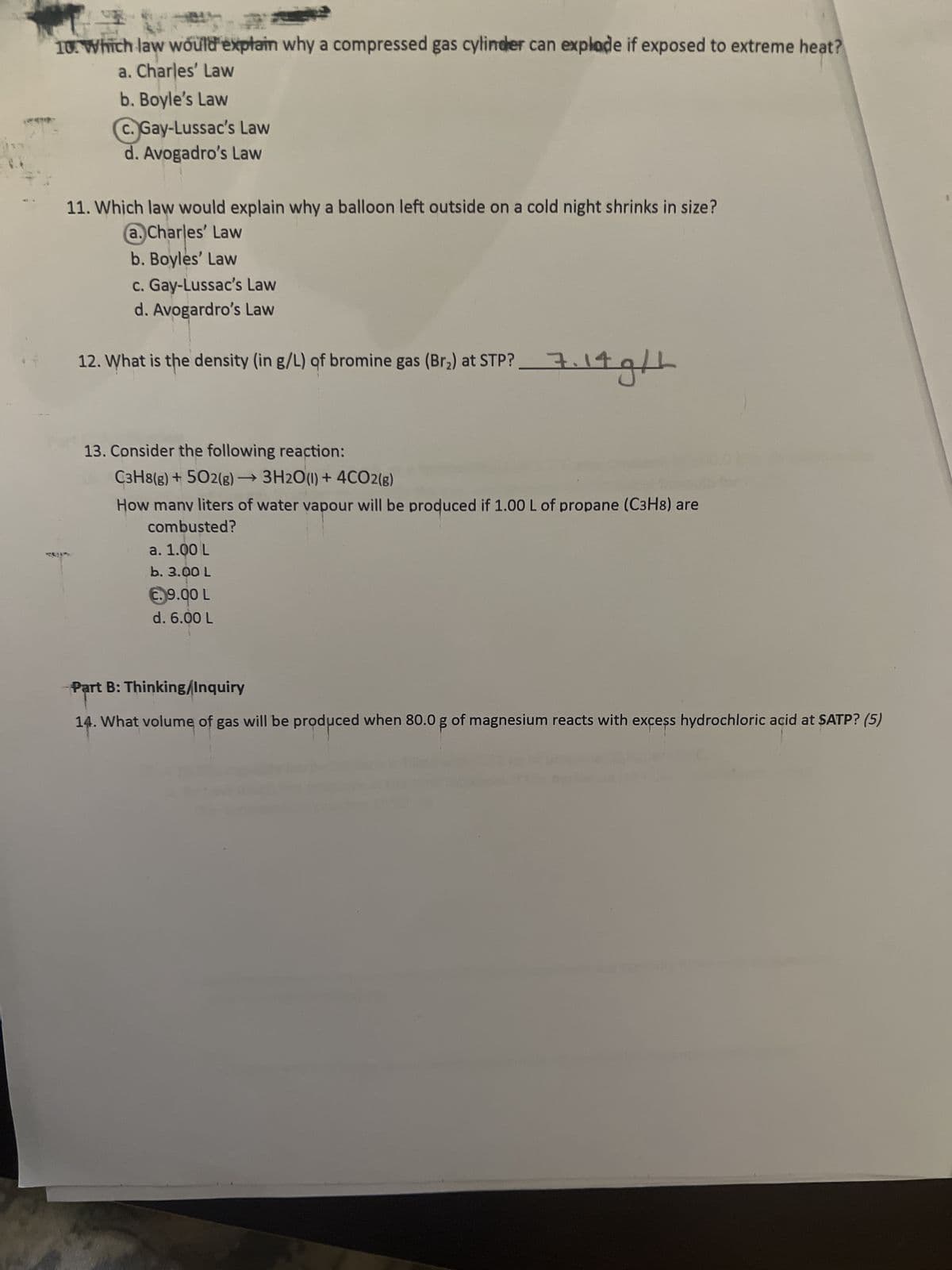으로 10. Which law would explain why a compressed gas cylinder can explade if exposed to extreme heat? a. Charles' Law b. Boyle's Law (C. Gay-Lussac's Law d. Avogadro's Law 11. Which law would explain why a balloon left outside on a cold night shrinks in size? a. Charles' Law b. Boyles' Law c. Gay-Lussac's Law d. Avogardro's Law 12. What is the density (in g/L) of bromine gas (Br₂) at STP? 13. Consider the following reaction: -7.14g|h C3H8(g) + 502(g) → 3H2O(l) + 4CO2(g) How many liters of water vapour will be produced if 1.00 L of propane (C3H8) are combusted? a. 1.00 L b. 3.00 L €9.00 L d. 6.00 L Part B: Thinking/Inquiry 14. What volume of gas will be produced when 80.0 g of magnesium reacts with excess hydrochloric acid at SATP? (5)
으로 10. Which law would explain why a compressed gas cylinder can explade if exposed to extreme heat? a. Charles' Law b. Boyle's Law (C. Gay-Lussac's Law d. Avogadro's Law 11. Which law would explain why a balloon left outside on a cold night shrinks in size? a. Charles' Law b. Boyles' Law c. Gay-Lussac's Law d. Avogardro's Law 12. What is the density (in g/L) of bromine gas (Br₂) at STP? 13. Consider the following reaction: -7.14g|h C3H8(g) + 502(g) → 3H2O(l) + 4CO2(g) How many liters of water vapour will be produced if 1.00 L of propane (C3H8) are combusted? a. 1.00 L b. 3.00 L €9.00 L d. 6.00 L Part B: Thinking/Inquiry 14. What volume of gas will be produced when 80.0 g of magnesium reacts with excess hydrochloric acid at SATP? (5)
Introductory Chemistry: A Foundation
9th Edition
ISBN:9781337399425
Author:Steven S. Zumdahl, Donald J. DeCoste
Publisher:Steven S. Zumdahl, Donald J. DeCoste
Chapter15: Solutions
Section: Chapter Questions
Problem 9CR
Related questions
Question

Transcribed Image Text:으로
10. Which law would explain why a compressed gas cylinder can explade if exposed to extreme heat?
a. Charles' Law
b. Boyle's Law
(C. Gay-Lussac's Law
d. Avogadro's Law
11. Which law would explain why a balloon left outside on a cold night shrinks in size?
a. Charles' Law
b. Boyles' Law
c. Gay-Lussac's Law
d. Avogardro's Law
12. What is the density (in g/L) of bromine gas (Br₂) at STP?
13. Consider the following reaction:
-7.14g|h
C3H8(g) + 502(g) → 3H2O(l) + 4CO2(g)
How many liters of water vapour will be produced if 1.00 L of propane (C3H8) are
combusted?
a. 1.00 L
b. 3.00 L
€9.00 L
d. 6.00 L
Part B: Thinking/Inquiry
14. What volume of gas will be produced when 80.0 g of magnesium reacts with excess hydrochloric acid at SATP? (5)
AI-Generated Solution
Unlock instant AI solutions
Tap the button
to generate a solution
Recommended textbooks for you

Introductory Chemistry: A Foundation
Chemistry
ISBN:
9781337399425
Author:
Steven S. Zumdahl, Donald J. DeCoste
Publisher:
Cengage Learning



Introductory Chemistry: A Foundation
Chemistry
ISBN:
9781337399425
Author:
Steven S. Zumdahl, Donald J. DeCoste
Publisher:
Cengage Learning



Chemistry
Chemistry
ISBN:
9781305957404
Author:
Steven S. Zumdahl, Susan A. Zumdahl, Donald J. DeCoste
Publisher:
Cengage Learning

Chemistry for Engineering Students
Chemistry
ISBN:
9781337398909
Author:
Lawrence S. Brown, Tom Holme
Publisher:
Cengage Learning

Chemistry: Principles and Reactions
Chemistry
ISBN:
9781305079373
Author:
William L. Masterton, Cecile N. Hurley
Publisher:
Cengage Learning